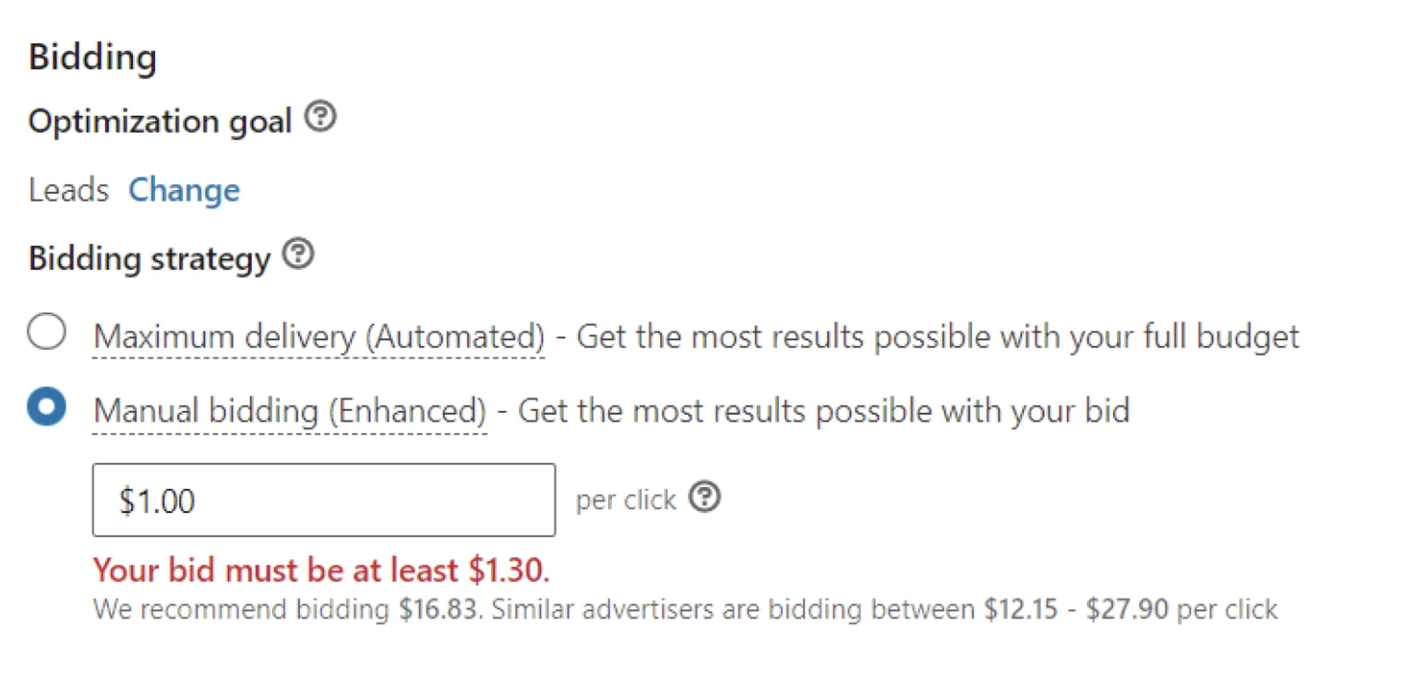Why You Need LinkedIn Ads and Who They're For
It is quite difficult for B2B companies to choose suitable advertising platforms. LinkedIn, like other platforms, has a number of advantages. And before you launch advertising on LinkedIn, you need to understand how suitable this platform is for your business. There are several criteria for evaluating the effectiveness of LinkedIn for business advertising.
LinkedIn advertising is a great fit for companies with the following characteristics:
- the product has a very narrow target audience;
- LTV (LifeTime Value) is at least $10,000 - $15,000 for the American and Western European markets (for Eastern Europe, Asia, etc. it may be less);
- The target audience consists of entrepreneurs, managers or senior specialists
LinkedIn users are not going to be ready to buy your products right away. They are not initially looking for your product or service, but they may become interested in it after learning about your offer through your content. Ultimately, the deal size needs to be large enough to offset the advertising costs and generate profit.
Who LinkedIn advertising is definitely not suitable for:
- to promote mobile applications;
- for e-Commerce business;
- for businesses whose target audience is the younger generation who have not yet started their careers.
What budget do you need to start?
If you decide to try LinkedIn advertising for the first time, then first conduct test campaigns. They will help you determine the optimal budget. $500 - $1000 is enough to conduct tests. The minimum budget for test campaigns can vary up to $300 - this is exactly how much is needed to obtain statistically significant results.
If we talk about the duration of the tests, it is better to allocate at least 1 week.
The optimal monthly budget for advertising on LinkedIn is from $3,000. These figures are given taking into account the targeting of the American market.
Campaign Goals: Effectiveness, Secrets and Strategies
What targets are available for use:
- Brand Awareness;
- Website visits;
- Engagement;
- Video views;
- Lead generation;
- Website conversions;
- Job applicants.
So how do you choose the right goals and practices? Let's take a closer look at each of these points.
Brand Awareness - the main goal is to tell as many people as possible about your products and services. Based on experience using this goal, it is not recommended to choose it. There is no possibility to change bids here, and this is an important component for campaign management.
Website visits - optimized for user clicks on ads to drive traffic to your site. Clicks will be very expensive, so unless you are willing to spend a large budget on driving traffic from LinkedIn, then using this goal is also not recommended.
Engagement - encourages users to interact with your ads through clicks, other actions (likes, comments, hashtags and reposts) or subscription to your company page on LinkedIn. You pay for each interaction with the ad. This objective provides a fairly low cost per click. The price of such a campaign can be 35% lower than for Lead generation or Website visits. You can also promote video ads using this objective instead of Video views. To do this, at the campaign setup stage, select the ad format - Video.
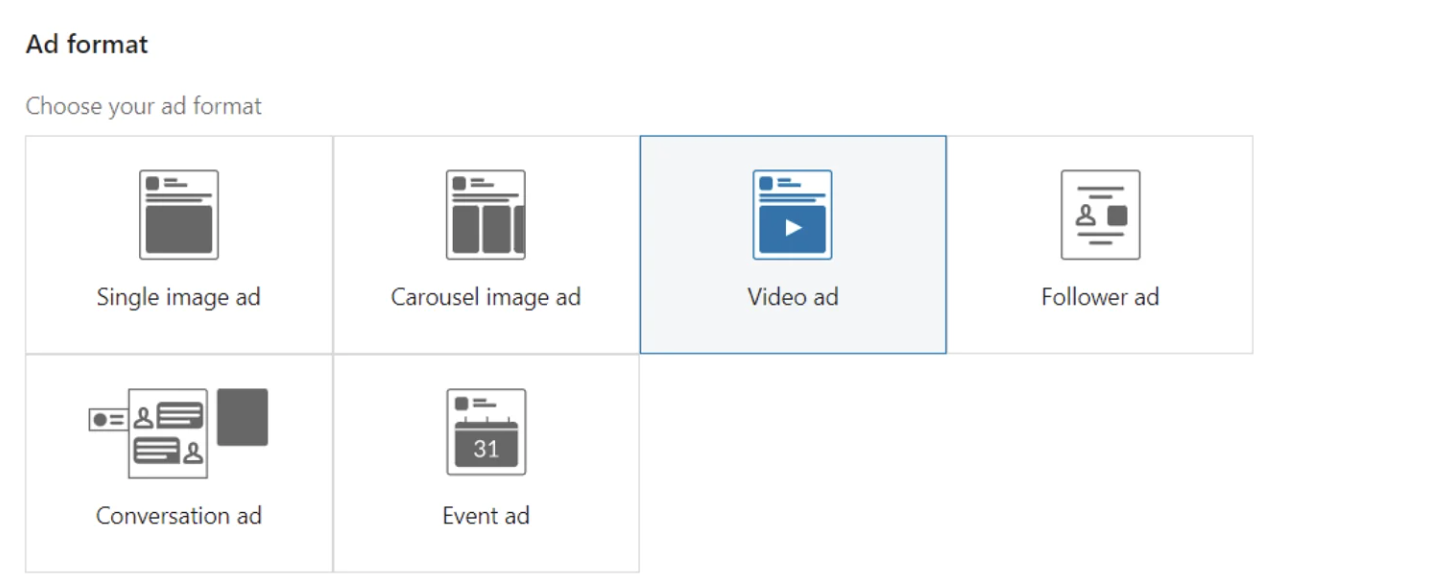
Video Views is the only objective that allows Cost per view bidding. LinkedIn counts a video view as one that a user watches for at least 2 seconds. This objective has the ability to retarget audiences based on video ad views. This is a good objective for getting video views at a relatively low cost. Don't forget to include captions for your video and a thumbnail.
Lead generation - forms with self-filling fields are used (if the user profile contains the requested information) . A good way to get leads at a low price. Of course, the cost may be higher, depending on the region of display and targeting settings. Automatic bidding, CPC, CPM are available here. You can achieve high quality leads if you set up targeting correctly and monitor the breakdowns in the Demographics report (which countries the impressions go to, which companies and for which positions).
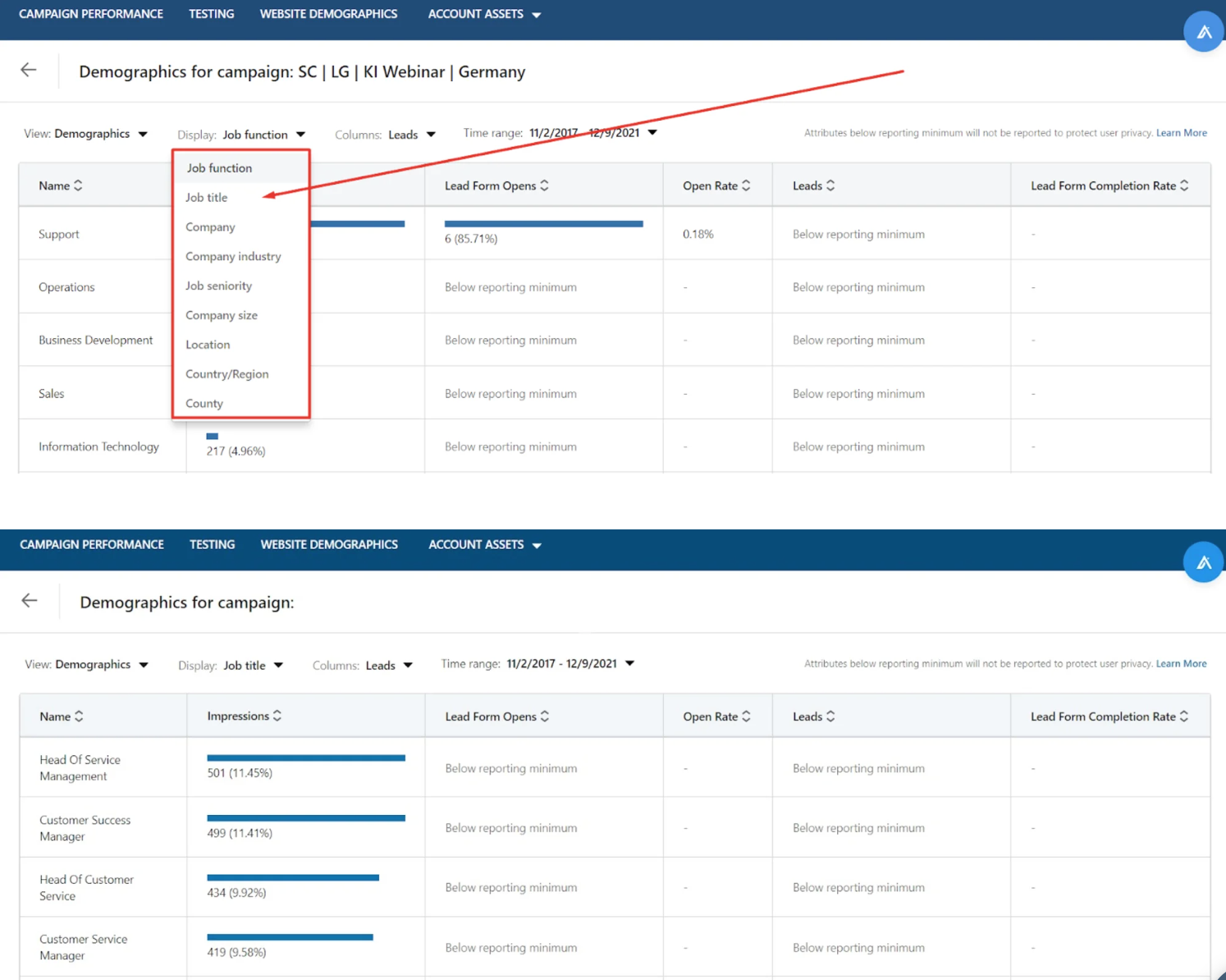
A regular report will not have data in the "Conversions" field, since lead generation conversions are shown in the Leads and Lead Opens fields. To view leads, it is better to connect special tools (Zappier, Hubspot, Salesforce to LinkedIn). Otherwise, you will have to open LinkedIn and download leads in CSV format.
Website conversions - optimized for actions on your website. LinkedIn's algorithm tries to show your ad to people who are most likely to convert. Tip: It's best not to use this objective, as LinkedIn doesn't have much data on user conversions.
Job applicants - this objective is used to recruit specialists on the LinkedIn platform. If your goal is to hunt top specialists, then feel free to choose this category.
How to Set Up Targeting That Works: Practical Tips and Examples
LinkedIn has the best targeting capabilities:
- positions;
- job levels;
- job responsibilities (has too broad a scope);
- skills / Skills (specified in the user profile);
- groups;
- company size;
- industry sectors of the company;
- company names (useful option for including and excluding from the targeting list)
- education
- demographic information (location)
- work experience (not recommended)
- Gender Matched Audience Targeting
- email targeting
- retargeting
- targeting by company list (up to 300,000 company names can be uploaded). Tip: If you want to use company lists in targeting, please allow 24-48 hours for LinkedIn to process .
- targeting by interests (the LinkedIn database contains templates that already contain audiences by interests, but you need to use this carefully)
Practical tips and examples
What is the most effective targeting option?
Job titles are one of the most popular and effective targeting options. LinkedIn is a platform for business and career, so people always leave the most accurate data about their position and work here. Targeting by Job Titles is a unique opportunity for you to show advertising of your product or service to the target audience. In targeting by positions, the percentage of coincidence is about 30%, since positions are entered by users in free form. This type of targeting is the most expensive, because it is in great demand among advertisers.
Tip: Exclude positions that are related to marketing and sales. Often, employees in these positions join various interest groups for the purpose of networking and potential sales, but of course, they will not be your target audience (the exception may be cases when you deliberately want to target sales and marketers). Therefore, it is better to exclude these positions to avoid wasting your budget on irrelevant users.
You can only exclude jobs if you don't use the jobs in your targeting.
What are some examples of targeting combinations that actually work?
1. Company Targeting:
Company Connections: Use Company Connections: targeting to reach 1st degree connections of employees at companies you select. (Companies must have 500+ employees.)
Company Followers: Use company follower targeting to reach followers of your own LinkedIn Page. (Your ad account must be linked to your LinkedIn Page.)
Company Name: You can target specific company names if you want to reach people who work at one specific location. This isn't limited to just current employees, you can search for past employees as well, as well as a combination of current or past employees, or past but not current employees.
Industry of the company: The industries are numerous, ranging from agriculture to education, finance, manufacturing, arts, corporate services, high tech, media, organizations and non-profits, transportation, and many others, including various offshoots.
Company size: You can target people by company size (1-10 employees, 11-50 and up). You can also target self-employed people. Company size is determined by the number of employees listed on the organization's LinkedIn page.
2. Skills + Seniority. Too broad. You can also use up to 50 skills in your profile. Try to include complex and specific (long tail) keywords. Remember that there are LinkedIn users who add professional skills to their profile but do not have them themselves. Therefore, a combination of skills with Seniority should solve this problem a little, but you still need to monitor the Demographics Report.
3. Group targeting is a pretty good option, as it requires little effort to join a specific LinkedIn group. Many group admins carefully select candidates to join the groups, which increases the relevance of the audience in these groups. Also test the combination: Job Titles + Groups. You can also manually start typing words that are relevant to you and LinkedIn will start suggesting targeting options for you.
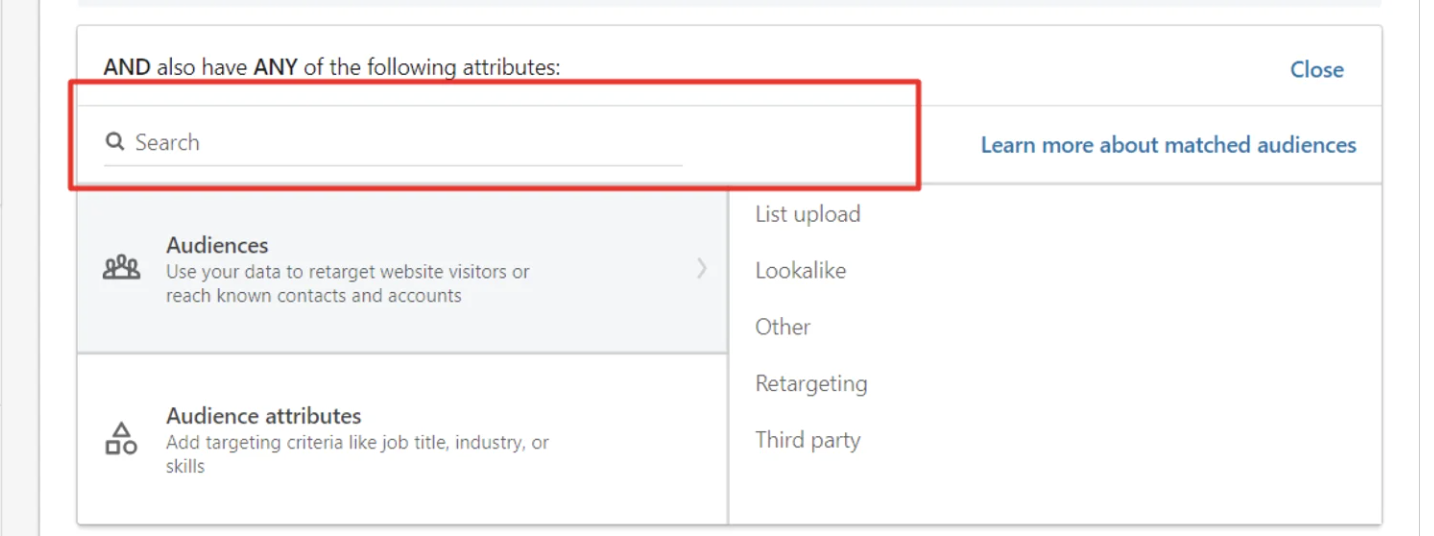
Audiences
When you do research on your audience, choose 5-10 ideal clients and 3-5 companies in your opinion and see what they have in common (groups, interests).
As for audience size, there is no exact answer as to what number to aim for. However, on average, it is believed that the ideal audience size can range between 20,000 and 80,000. Do not take these numbers as a rule, there are always exceptions, but in most cases, this range works well.
Ignore the Enable Audience Expansion option. LinkedIn will look for people to show your ads to who are similar to your ideal customers. In practice, this option works poorly, so we uncheck it.
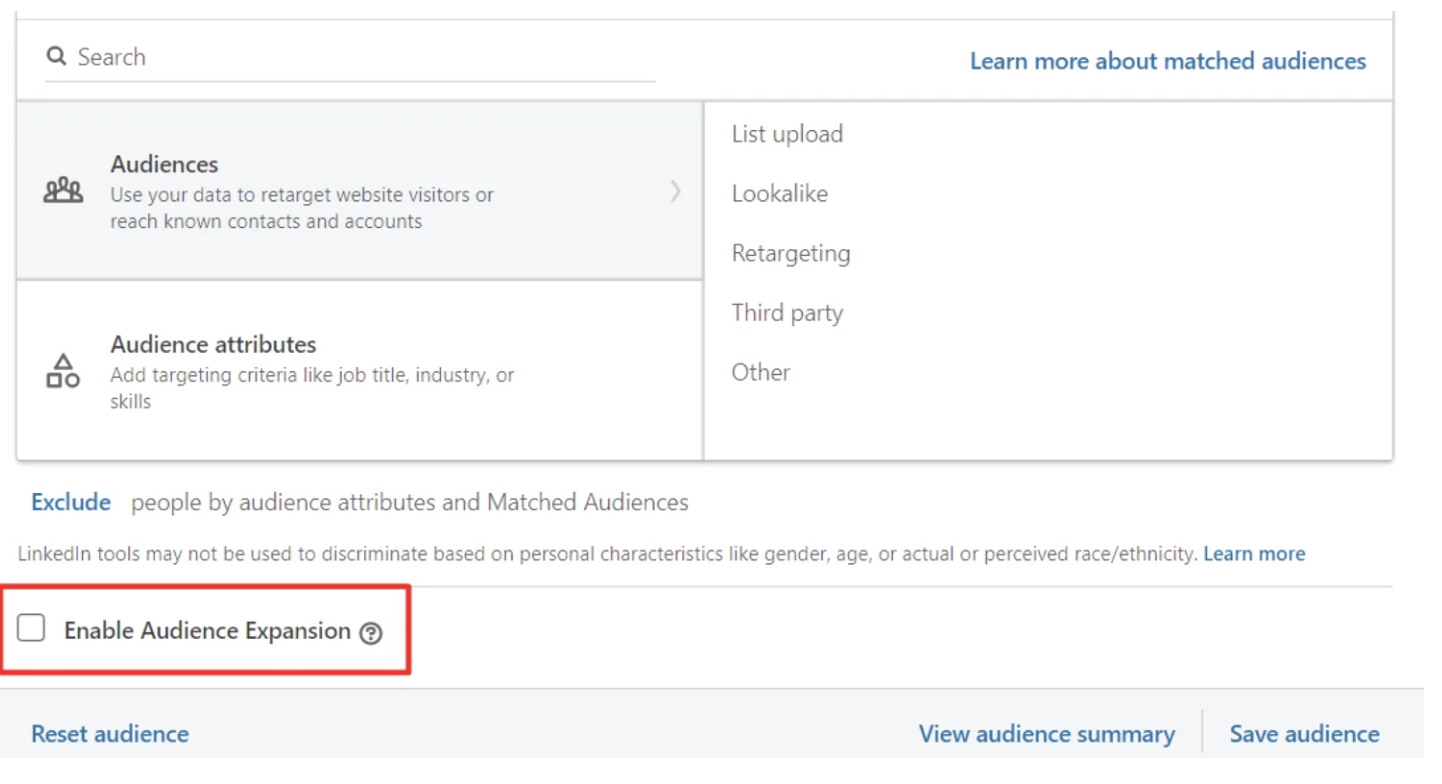
Once you have completed creating your audience and all targeting settings are ready, save this audience by clicking Save Audience in your account. Audiences are stored in your profile and can be used in other accounts.
What to do if there is no company page on LinkedIn?
If there is no company page, then contacts who work for this company are assigned the status “unknown”.
What if you still need to include such companies in your target audience?
You can capture these companies by excluding large companies, so LinkedIn will target small companies and companies with the “unknown” status.
Why is CPM too high?
The narrower your audience, the higher your CPM. Therefore, if it turns out that your CPM is very high, for example, more than $250, then look at the targeting settings, you probably have a narrowing of the audience by different parameters, which greatly limits LinkedIn in impressions.
LinkedIn Audience Network
This option allows you to expand the reach of your campaigns by showing ads outside of your LinkedIn feed, to members of third-party apps and sites. Tip: Do not check this box. As an exception, you can select this option if your audience is very small.
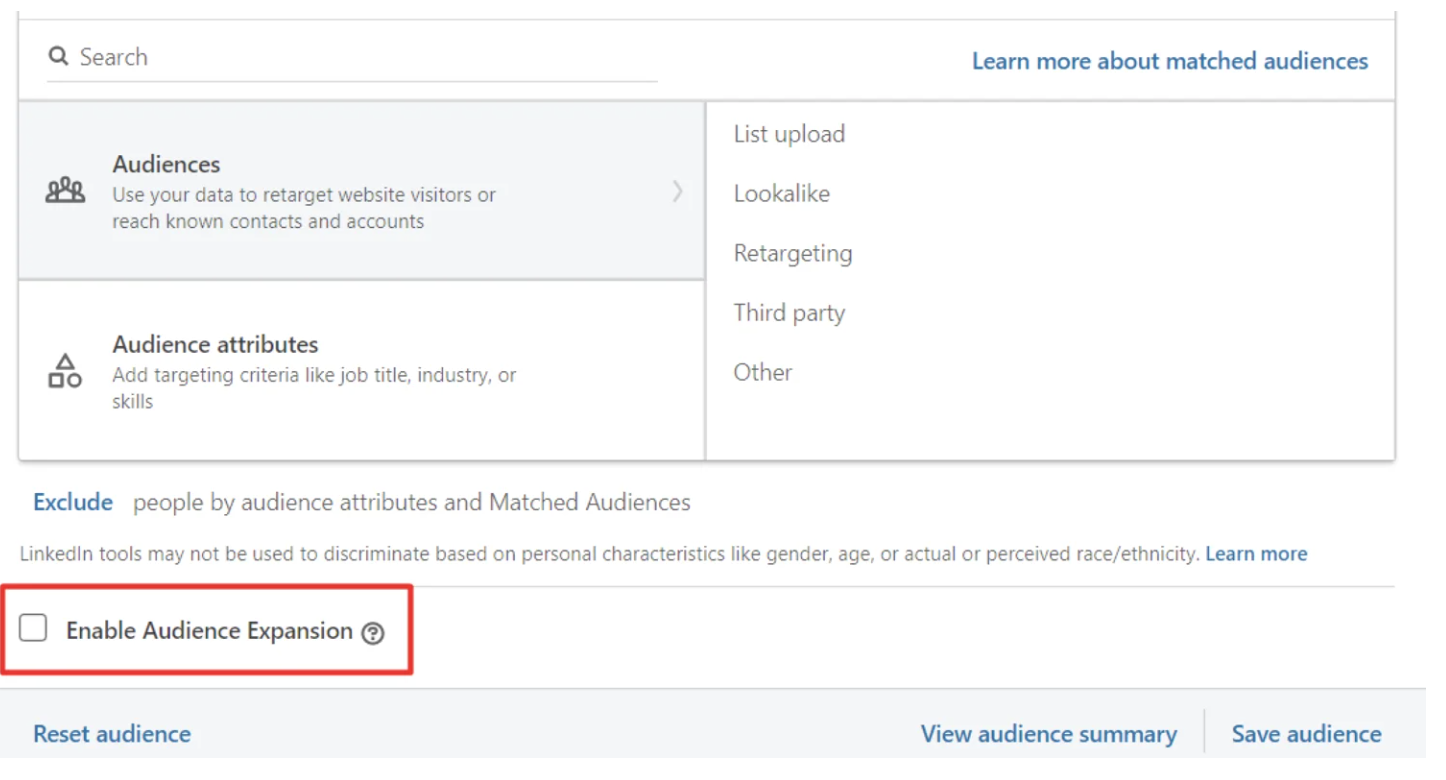
Lookalike audiences
Original targeting on LinkedIn works very well, so you should definitely not think that targeting by Lookalike audiences will perform better than original targeting. In fact, Lookalike audiences work on the principle of Audience Expansion, which you can choose at any time. The only advantage is that you can now target this audience in a separate campaign, rather than having it all mixed up if you check the Audience Expansion box when creating a campaign.
Lookalike audiences work best when they are built on customer lists with contacts that don't have exact Job Titles and company types, but LinkedIn will be able to find the right audience.
Loading list of companies for targeting
When you upload a list of companies to LinkedIn, you cannot be sure that LinkedIn will “recognize” all the companies, so it is a good idea to enter the companies manually (unless your list is more than 200 companies).
If you upload a list of companies, always include the company URL in your list, this will help increase the recognition rate. In terms of cost, the cost per click will be high if you target large enterprise-level companies.
Types of bidding: what works best
Let's take a look at the existing bidding models on LinkedIn and identify effective categories to achieve the desired results without burning through your budget.
- Automated Bidding (uses CPM). This method uses CPM bidding and charges for every 1,000 impressions. In this case, the advertiser allows the algorithm to set bids without a maximum cost. Sometimes, depending on the competition, your costs may vary.
- Maximum CPC Bidding. This method allows advertisers to control their costs and set the maximum bid amount they are willing to spend. When you choose this method, you tell the algorithm that you want to maximize clicks and only pay when a user clicks on your ad.
- Enhanced CPC Bidding. This method is only available for campaign objectives such as Website visits, Lead generation, or Engagement. With this bidding strategy, the algorithm will deliver your ads to users who are more likely to convert based on the selected campaign objective. Note: The only difference between Enhanced CPC and Maximum CPC is that when you select a campaign objective (Website visits, Conversions, or Lead generation), the algorithm will optimize for that objective. For example, if you set your campaign objective to "Website visits" and your bids to "Enhanced CPC", the algorithm will automatically optimize your bids for users who are more likely to click on your ad.
- Cost-per-impression (CPM) bidding: This method allows advertisers to control their bids per 1,000 impressions without LinkedIn setting the bids for you. CPM is great if you want to increase product visibility and/or brand awareness through a marketing campaign.
Types and formats of advertising. Where to start
- Sponsored Content. Ads are shown in the news feed. Average CTR is .4%. Includes text up to 128 characters, headline up to 38 characters. 70% of views are carried out by users on mobile devices. Image resolution is 1200 X 627 px.
- Text ads - displayed on the right side of the screen. This type of ads is good for getting traffic from Desktop. The disadvantages include the fact that such ads look like ads and thus scare away users.
Format - 50x50, size 100x100. This is a less risky way to get cheap clicks with a low level of interaction with the ad. The average CTR for text ads is .03%.
- Message ads - you pay every time you send a message. There is no guarantee that your message will be opened. Average cost per click is $22-$27. Use this type of ad if you are sure that your offer should be perceived as a personal invitation.
- Dynamic advertising - located on the right side of the screen. Low clickability, high cost - not the best option.
- Video advertising is one form of Sponsored Content on LinkedIn.
- Advertising carousel with images.
- Lead generation forms - when users fill out forms without leaving the LinkedIn platform. The conversion rate is 10%-20% higher, but the quality of the leads may not be the highest, so it is important to monitor the reports from the Demographics report. The less information you ask for in the forms, the higher the conversion rate to leads. So leave only those fields that are critical for you and your sales team.
It is recommended to leave only the following fields in the forms: first name, last name, email, LinkedIn profile URL. This type of ad is great for starting to test your offer. If your lead generation campaign is targeting different countries, then be sure to include a policy page in the local language. In addition, the ad text should be in the same language.
